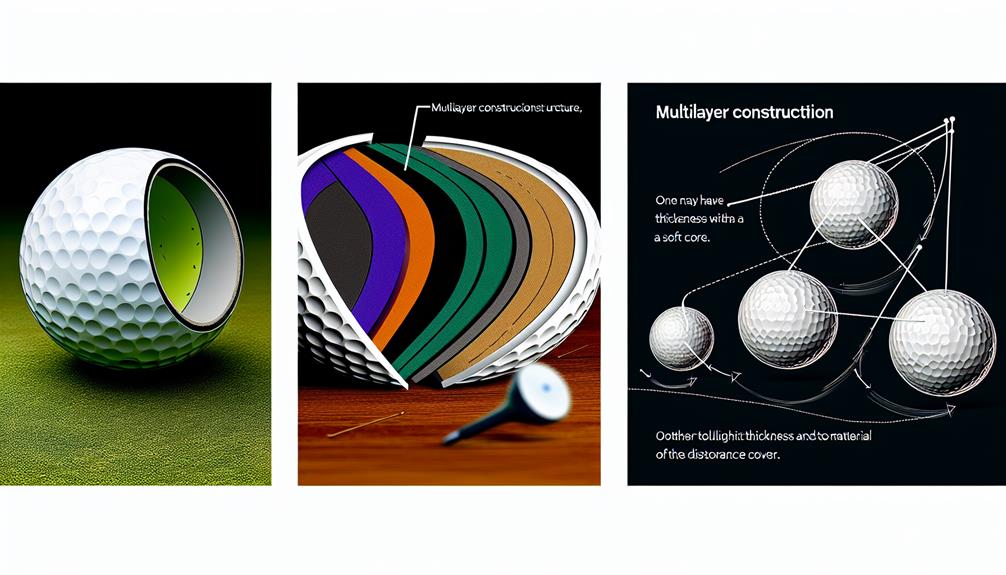You might think all golf balls are created equal, right? They're just small, round objects designed for whacking across a green expanse.
Well, you couldn't be more wrong. Behind the seemingly simple exterior, there is a complex world of design, construction, material choice, and even aerodynamics that separate the average golf ball from the exceptional.
It's a fascinating realm that might change the way you look at that tiny dimpled sphere. So, are you ready to discover what makes some golf balls outperform others?
Understanding Golf Ball Construction
When you're selecting your ideal golf ball, it's crucial to understand the basics of golf ball construction, as it significantly impacts your game's performance and outcome. The core layers and dimple patterns are two vital elements that deserve close attention.
First, let's delve into the core layers. These are the heart of your ball's construction. A golf ball's core could be single, dual, or multi-layered. A single core often provides distance but not much control. In contrast, dual and multi-layered cores balance between distance and control. You'll find that balls with multi-layered cores offer better spin control, especially with your iron shots.
Now, onto dimple patterns. They're the small indentations that cover the ball's surface. Far from being just a design feature, these dimples actually play a crucial role in the ball's aerodynamics. They create turbulence in the boundary layer of air around the ball, reducing drag and helping the ball to travel further. Each manufacturer has its own unique dimple pattern, and this can affect not only the distance but also the trajectory and stability of your shots.
Understanding these aspects enhances your ability to choose the right ball for your game.
Influence of Ball Design on Performance
Having absorbed the essentials of golf ball construction, you're now well-equipped to explore how this intricate design directly impacts a ball's performance on the golf course.
The aerodynamics effects are the first crucial aspect of ball design. The dimple pattern on a golf ball's surface significantly influences its lift and drag in flight. A smoother ball experiences more air resistance and thus travels a shorter distance. To counteract this, golf balls are designed with dimples that create turbulence in the boundary layer of air around the ball, reducing drag and enhancing lift, thereby maximizing distance.
Spin control is another critical factor deeply tied to ball design. The materials used in the cover and the core affect a ball's spin rates. A softer cover grips the clubface better, resulting in higher spin for short approach shots, allowing you to stop the ball on the green more effectively. Conversely, a firmer core helps to reduce spin off the driver, enhancing distance for long drives.
Comparison of Leading Golf Ball Brands
In your quest to find the perfect golf ball, comparing the offerings from leading brands can give you a comprehensive overview of the performance characteristics you should expect on the course. It's essential to look beyond brand loyalty, as market trends indicate a shift in performance standards among top manufacturers.
Titleist, for instance, leads in brand loyalty due to its consistent performance and premium feel. However, Callaway's Chrome Soft ball, with its Graphene-infused Dual SoftFast Core, delivers exceptional speed and low spin off the driver, challenging Titleist's dominance.
Bridgestone, on the other hand, focuses on fitting balls to individual swing types. Their e6 series provides low spin and straight flight, perfect for mid-handicappers.
Meanwhile, TaylorMade's TP5 and TP5x offer a five-layer construction aimed at optimizing flight, spin, and speed regardless of the club used. This makes them a versatile choice for skilled players.
Srixon's Z-Star series boasts a softer feel with high greenside spin, while Wilson's Duo Soft+ offers great value for casual players seeking distance and feel.
In essence, the 'perfect' golf ball is highly subjective, dependent on your specific playing style, skill level, and preferences. Don't let brand loyalty blind you; explore the diverse offerings from various manufacturers to find your ideal match.
Role of Material in Ball Performance
While exploring different brands and their unique offerings, it's crucial to consider the role of material composition in golf ball performance. Material durability and aerodynamic properties are two key factors that can significantly impact the ball's performance on the golf course.
Material durability refers to the strength of the golf ball's construction. A ball made from durable materials can withstand the high-speed impacts that occur during a golf game without deforming or breaking apart. This durability allows the ball to maintain its shape and structure, which contributes to consistent performance over time.
Meanwhile, the aerodynamic properties of a golf ball are largely determined by its material composition and design. The right materials can enhance a ball's lift, drag, and spin, influencing its trajectory and distance. For instance, a ball with a hard, smooth surface will typically have better aerodynamic properties than one with a softer, textured surface.
Impact of Ball Compression on Distance
You mightn't realize it, but the compression of a golf ball plays a crucial role in the distance it can travel when struck. The compression rating of a ball measures its potential deformation under impact. When you swing, the ball compresses against the club's face and then springs back to its original shape, propelling it into the air.
This isn't just theory, it's physics. The higher the compression rating, the less the ball will compress on impact and the farther it will fly. But there's a catch. Higher compression balls require higher swing speeds to fully compress and maximize distance. If your swing speed doesn't match the ball's compression rating, you'll lose distance.
For example, if you've a slower swing speed, you'll benefit from a lower compression ball. It'll compress more easily, giving you more distance. Conversely, if your swing speed is fast, a higher compression ball will provide optimal distance as it won't over-compress.

